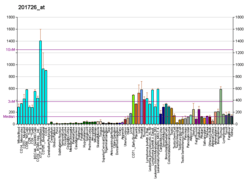ELAV-like protein 1
ELAV-like protein 1 or HuR (human antigen R) is a protein that in humans is encoded by the ELAVL1 gene.[5][6]
The protein encoded by this gene is a member of the ELAVL protein family. This encoded protein contains 3 RNA-binding domains and binds cis-acting AU-rich elements. One of its best-known functions is to stabilize mRNAs in order to regulate gene expression.[7]
See also
References
- 1 2 3 GRCh38: Ensembl release 89: ENSG00000066044 - Ensembl, May 2017
- 1 2 3 GRCm38: Ensembl release 89: ENSMUSG00000040028 - Ensembl, May 2017
- ↑ "Human PubMed Reference:".
- ↑ "Mouse PubMed Reference:".
- ↑ Ma WJ, Cheng S, Campbell C, Wright A, Furneaux H (Jun 1996). "Cloning and characterization of HuR, a ubiquitously expressed Elav-like protein". J Biol Chem. 271 (14): 8144–8151. doi:10.1074/jbc.271.14.8144. PMID 8626503.
- ↑ Ma WJ, Furneaux H (Feb 1997). "Localization of the human HuR gene to chromosome 19p13.2". Hum Genet. 99 (1): 32–33. doi:10.1007/s004390050305. PMID 9003489.
- ↑ "Entrez Gene: ELAVL1 ELAV (embryonic lethal, abnormal vision, Drosophila)-like 1 (Hu antigen R)".
Further reading
- Nabors LB, Suswam E, Huang Y, Yang X, Johnson MJ, King PH (2003). "Tumor necrosis factor alpha induces angiogenic factor up-regulation in malignant glioma cells: a role for RNA stabilization and HuR". Cancer Res. 63 (14): 4181–7. PMID 12874024.
- Abdelmohsen K, Lal A, Kim HH, Gorospe M (2007). "Posttranscriptional orchestration of an anti-apoptotic program by HuR". Cell Cycle. 6 (11): 1288–92. doi:10.4161/cc.6.11.4299. PMID 17534146.
- Bonaldo MF, Lennon G, Soares MB (1997). "Normalization and subtraction: two approaches to facilitate gene discovery". Genome Res. 6 (9): 791–806. doi:10.1101/gr.6.9.791. PMID 8889548.
- Sakai K, Kitagawa Y, Hirose G (1999). "Analysis of the RNA recognition motifs of human neuronal ELAV-like proteins in binding to a cytokine mRNA". Biochem. Biophys. Res. Commun. 256 (2): 263–268. doi:10.1006/bbrc.1999.0282. PMID 10079173.
- Wang W, Furneaux H, Cheng H, et al. (2000). "HuR regulates p21 mRNA stabilization by UV light". Mol. Cell. Biol. 20 (3): 760–769. doi:10.1128/MCB.20.3.760-769.2000. PMC 85192. PMID 10629032.
- Blaxall BC, Pellett AC, Wu SC, et al. (2000). "Purification and characterization of beta-adrenergic receptor mRNA-binding proteins". J. Biol. Chem. 275 (6): 4290–4297. doi:10.1074/jbc.275.6.4290. PMID 10660597.
- Park S, Myszka DG, Yu M, et al. (2000). "HuD RNA recognition motifs play distinct roles in the formation of a stable complex with AU-rich RNA". Mol. Cell. Biol. 20 (13): 4765–4772. doi:10.1128/MCB.20.13.4765-4772.2000. PMC 85909. PMID 10848602.
- Spångberg K, Wiklund L, Schwartz S (2000). "HuR, a protein implicated in oncogene and growth factor mRNA decay, binds to the 3' ends of hepatitis C virus RNA of both polarities". Virology. 274 (2): 378–390. doi:10.1006/viro.2000.0461. PMID 10964780.
- Brennan CM, Gallouzi IE, Steitz JA (2000). "Protein ligands to HuR modulate its interaction with target mRNAs in vivo". J. Cell Biol. 151 (1): 1–14. doi:10.1083/jcb.151.1.1. PMC 2189805. PMID 11018049.
- Gallouzi IE, Steitz JA (2001). "Delineation of mRNA export pathways by the use of cell-permeable peptides". Science. 294 (5548): 1895–1901. doi:10.1126/science.1064693. PMID 11729309.
- Goldberg-Cohen I, Furneauxb H, Levy AP (2002). "A 40-bp RNA element that mediates stabilization of vascular endothelial growth factor mRNA by HuR". J. Biol. Chem. 277 (16): 13635–13640. doi:10.1074/jbc.M108703200. PMID 11834731.
- Wang W, Fan J, Yang X, et al. (2002). "AMP-activated kinase regulates cytoplasmic HuR". Mol. Cell. Biol. 22 (10): 3425–3436. doi:10.1128/MCB.22.10.3425-3436.2002. PMC 133799. PMID 11971974.
- Yeap BB, Voon DC, Vivian JP, et al. (2002). "Novel binding of HuR and poly(C)-binding protein to a conserved UC-rich motif within the 3'-untranslated region of the androgen receptor messenger RNA". J. Biol. Chem. 277 (30): 27183–27192. doi:10.1074/jbc.M202883200. PMID 12011088.
- Li H, Park S, Kilburn B, et al. (2003). "Lipopolysaccharide-induced methylation of HuR, an mRNA-stabilizing protein, by CARM1. Coactivator-associated arginine methyltransferase". J. Biol. Chem. 277 (47): 44623–44630. doi:10.1074/jbc.M206187200. PMID 12237300.
- Chen CY, Xu N, Shyu AB (2002). "Highly selective actions of HuR in antagonizing AU-rich element-mediated mRNA destabilization". Mol. Cell. Biol. 22 (20): 7268–7278. doi:10.1128/MCB.22.20.7268-7278.2002. PMC 139819. PMID 12242302.
- Giles KM, Daly JM, Beveridge DJ, et al. (2003). "The 3'-untranslated region of p21WAF1 mRNA is a composite cis-acting sequence bound by RNA-binding proteins from breast cancer cells, including HuR and poly(C)-binding protein". J. Biol. Chem. 278 (5): 2937–2946. doi:10.1074/jbc.M208439200. PMID 12431987.
- Strausberg RL, Feingold EA, Grouse LH, et al. (2003). "Generation and initial analysis of more than 15,000 full-length human and mouse cDNA sequences". Proc. Natl. Acad. Sci. U.S.A. 99 (26): 16899–16903. doi:10.1073/pnas.242603899. PMC 139241. PMID 12477932.
- Wang W, Yang X, López de Silanes I, et al. (2003). "Increased AMP:ATP ratio and AMP-activated protein kinase activity during cellular senescence linked to reduced HuR function". J. Biol. Chem. 278 (29): 27016–27023. doi:10.1074/jbc.M300318200. PMID 12730239.
This article incorporates text from the United States National Library of Medicine (), which is in the public domain.
This article is issued from
Wikipedia.
The text is licensed under Creative Commons - Attribution - Sharealike.
Additional terms may apply for the media files.





